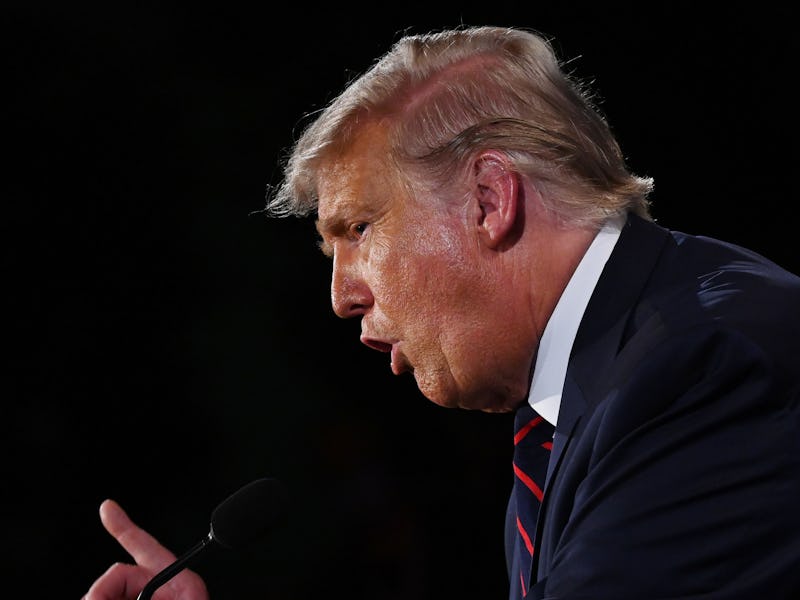Linguistic science has revealed a stunning truth about a chaotic debate
"Will you shut up, man?"

During Tuesday's debate, President Donald Trump and Democratic nominee Joe Biden were supposed to square off on the coronavirus pandemic, systemic racism, healthcare, and Trump's tax returns. Instead, we got a chaotic mismatch of half sentences that left 69 percent of viewers, per a CBS poll, feeling "annoyed."
The interruptions made for a debate that felt nearly impossible to follow, but there was a lot of information exchanged beneath the surface.
Trump interrupted moderator Chris Wallace and Biden 128 times during the debate, per Slate's count. That's more than the 51 times he interrupted 2016 Democratic nominee Hillary Clinton in 2016 (compared to Clinton's 17).
Trump's habit of consistently interrupting is an example of a "Face-Threatening Action," explains Brian Larson, as associate professor at Texas A&M University School of Law who has studied rhetoric and argumentation. It's a specific type of interruption intended to diminish social power of the speaker.
"There are certainly people who we expect to be interrupted less frequently than others because of their authority or position," Larson tells Inverse. "By interrupting, you can hope to break down the impression that they have that authority."
Trump's face-threatening actions may have stolen the stage last night, but if you know what to look for, Biden got his shots in there, too.
Trump and Biden face off in the first 2020 presidential debate.
Trump's Strategy – Trump was engaging in quick interruptions, sometimes two or three interjections like the word: "Wrong" or phrase: "So, if we had listened to you."
Then he launches into an entirely new topic. Those quick additions helped Trump direct the conversation away from things like his record on the coronavirus pandemic, for instance.
That pattern of interruption speeds up the pace of the conversation, says Larson. If you look at past debates, there is a slower pace of conversation borne of taking turns. He points to the Reagan-Carter debate of 1980, but even more recent debates, like the Obama-Romney debate of 2012 had a slower cadence, even in "heated" moments.
Speeding the conversation up can lead to "disfluencies," says Larson. Those are quick mistakes or misstatements that require the speaker to back up and correct themselves. A slower pace is better for the speaker, because it allows them to fully articulate an idea.
Biden also has a stutter, which, as he described in a 2011 essay in People Magazine, he has helped manage by assigning a "cadence" to his speaking. Nonetheless, Trump's patten of interruption made it difficult to establish a rhythm.
"Last night, Mr. Biden had a lot of disfluencies," says Larson. "The challenge was probably greater because he was trying to describe policy positions. It's harder when you're doing that and trying to speak quickly."
Biden's Strategy – Biden's pattern of interruption was more nuanced. Larson points to body language on Biden's part that attempt to "cast doubt" on Trump's statements like head shaking, or uttering what Larson calls "a derisive laugh." These moves also count as face-threatening actions because they try to change the power dynamic within a conversation.
There's also examples of body language used to express dissatisfaction or laughter from the Reagan-Carter debate, as Larson points out. So this strategy isn't exactly new.
Watch Regan's body language during Carter's turn speaking.
Biden also got a few verbal shots in there. His first words onstage, as Larson points out, were "how you doing, man?" As Trump's interjections mounted, Biden replied "Donald, would you just be quiet for a minute" – something you might hear a parent say to a child. Finally, Biden escalated to this exclamation: "Will you shut up, man?"
"There's always this 'man' at the end, which is a kind of informal use of language that you wouldn't normally use in a professional context," says Larson.
That type of language, Larson says, can help diminish the perceived power differences that may be playing out on the stage as a result of both Trump's interruptions and his status as the President.
Biden also directed causal, almost joking language at Wallace, too. When Wallace told Biden he had two uninterrupted minutes to answer a question on the public health response to coronavirus, Biden replied "Good luck."
He is, in a sense, trying to paint Trump as the uncooperative interloper," says Larson.
Trump and Biden at the 2020 presidential debate.
Are face-threatening actions the future of debate? – Face-threatening actions were clearly on display last night – urging questions as to whether we should have just given Wallace the power to cut the mic and restore order. Larson questions whether that would have helped very much. After all, the candidates could have just kept yelling over one another, he says.
The best we might be able to hope for (short of getting the candidates in some sound-proofed booths) is that one day, this style of rapid-fire interruption-based debates fades away.
"I could see us returning to a situation where you have two candidates who are more focused on appearing presidential and observing conversational norms," says Larson.
"And after the last few years, some of us might consider that a relief."
.